Genetically Modified Microorganisms for Environmental Bioremediation
VerifiedAdded on 2020/06/04
|19
|6311
|97
Report
AI Summary
This report delves into the application of genetically modified microorganisms for bioremediation, focusing on the removal of heavy metals from contaminated environments. The introduction establishes the significance of heavy metal pollution stemming from industrial activities and outlines the health risks associated with exposure. The report then explores the processes of genetic modification, including methods like transformation, transposition, and CRISPR/Cas9, to enhance microbial capabilities for bioremediation. It highlights the mechanisms of bioremediation, such as phytoextraction and microbial degradation, and discusses the effectiveness of these methodologies. The application section covers the advantages and disadvantages of using genetically modified microorganisms, providing a comprehensive overview of the subject. The report also touches upon the impact of heavy metals on human health, emphasizing the importance of bioremediation efforts to mitigate environmental and health hazards. The document provides a detailed analysis of different bioremediation techniques and their effectiveness.
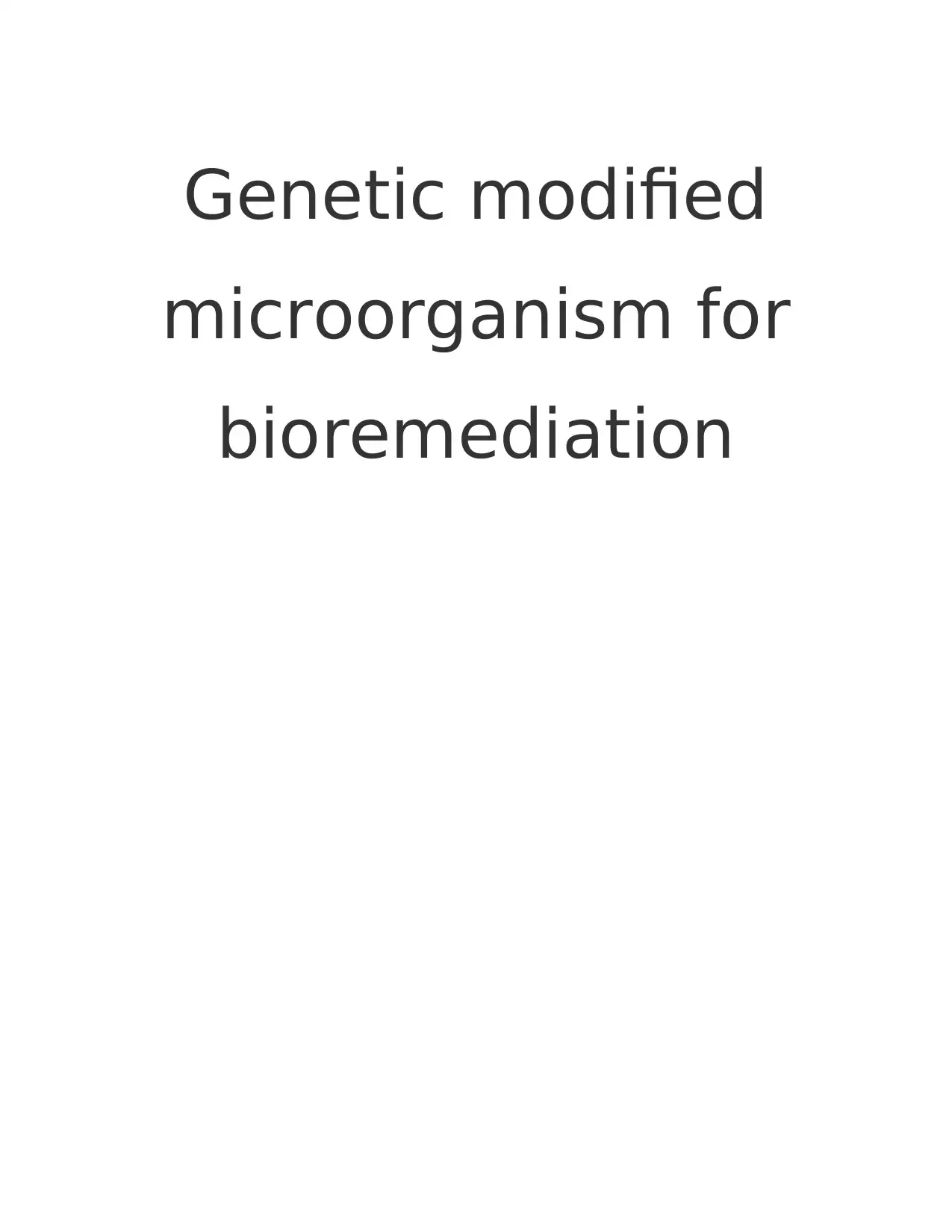
Genetic modified
microorganism for
bioremediation
microorganism for
bioremediation
Paraphrase This Document
Need a fresh take? Get an instant paraphrase of this document with our AI Paraphraser
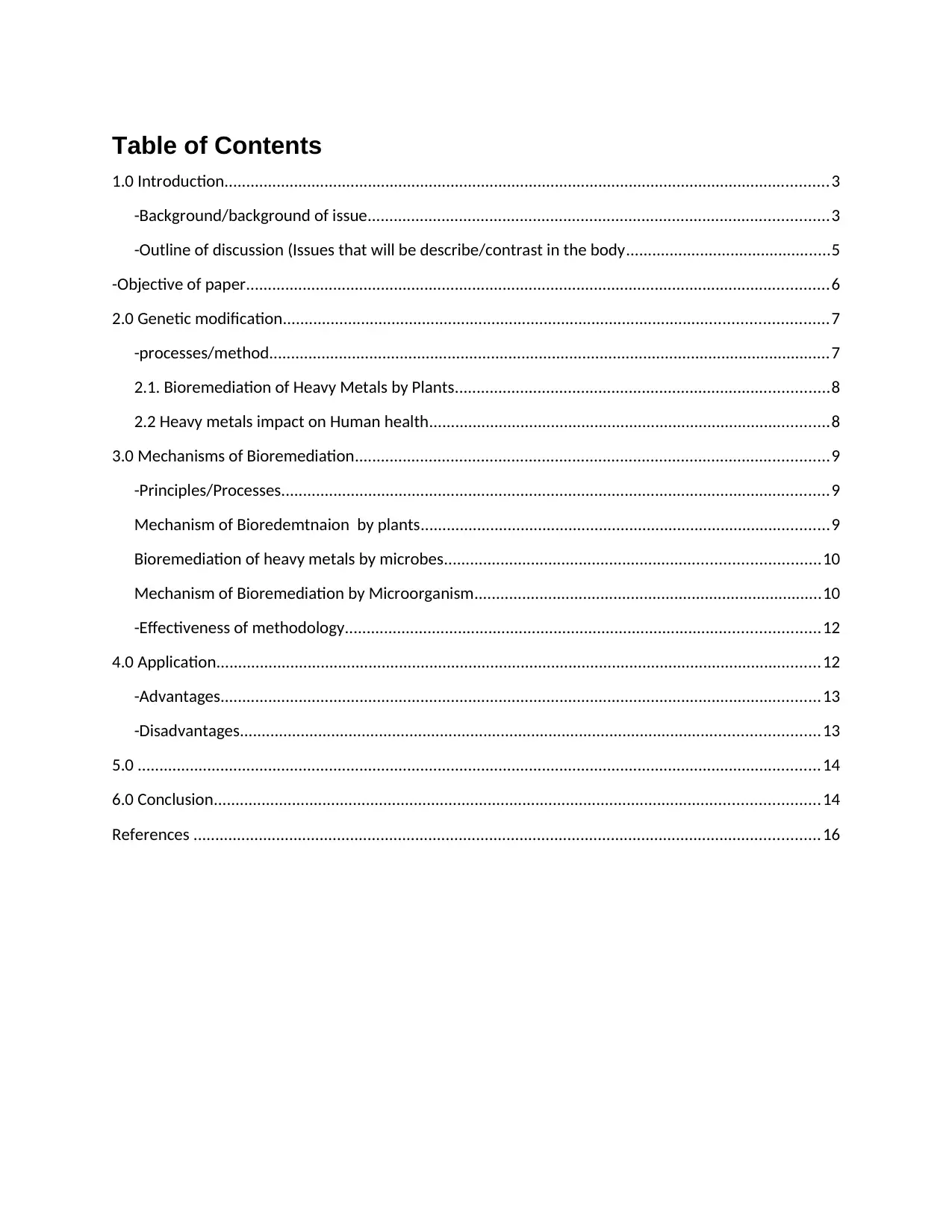
Table of Contents
1.0 Introduction...........................................................................................................................................3
-Background/background of issue..........................................................................................................3
-Outline of discussion (Issues that will be describe/contrast in the body...............................................5
-Objective of paper......................................................................................................................................6
2.0 Genetic modification.............................................................................................................................7
-processes/method.................................................................................................................................7
2.1. Bioremediation of Heavy Metals by Plants......................................................................................8
2.2 Heavy metals impact on Human health............................................................................................8
3.0 Mechanisms of Bioremediation.............................................................................................................9
-Principles/Processes..............................................................................................................................9
Mechanism of Bioredemtnaion by plants..............................................................................................9
Bioremediation of heavy metals by microbes......................................................................................10
Mechanism of Bioremediation by Microorganism................................................................................10
-Effectiveness of methodology.............................................................................................................12
4.0 Application...........................................................................................................................................12
-Advantages..........................................................................................................................................13
-Disadvantages.....................................................................................................................................13
5.0 .............................................................................................................................................................14
6.0 Conclusion...........................................................................................................................................14
References ................................................................................................................................................16
1.0 Introduction...........................................................................................................................................3
-Background/background of issue..........................................................................................................3
-Outline of discussion (Issues that will be describe/contrast in the body...............................................5
-Objective of paper......................................................................................................................................6
2.0 Genetic modification.............................................................................................................................7
-processes/method.................................................................................................................................7
2.1. Bioremediation of Heavy Metals by Plants......................................................................................8
2.2 Heavy metals impact on Human health............................................................................................8
3.0 Mechanisms of Bioremediation.............................................................................................................9
-Principles/Processes..............................................................................................................................9
Mechanism of Bioredemtnaion by plants..............................................................................................9
Bioremediation of heavy metals by microbes......................................................................................10
Mechanism of Bioremediation by Microorganism................................................................................10
-Effectiveness of methodology.............................................................................................................12
4.0 Application...........................................................................................................................................12
-Advantages..........................................................................................................................................13
-Disadvantages.....................................................................................................................................13
5.0 .............................................................................................................................................................14
6.0 Conclusion...........................................................................................................................................14
References ................................................................................................................................................16
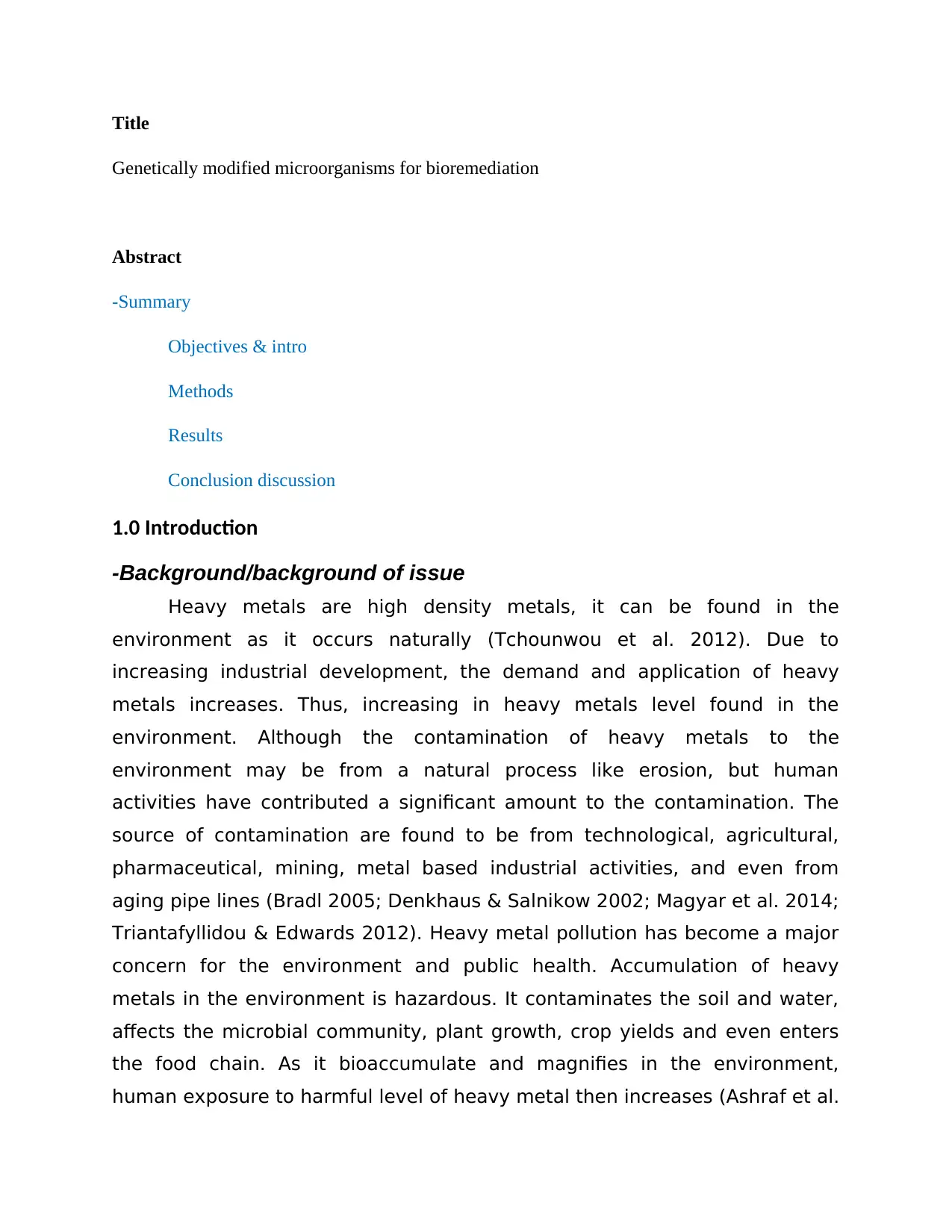
Title
Genetically modified microorganisms for bioremediation
Abstract
-Summary
Objectives & intro
Methods
Results
Conclusion discussion
1.0 Introduction
-Background/background of issue
Heavy metals are high density metals, it can be found in the
environment as it occurs naturally (Tchounwou et al. 2012). Due to
increasing industrial development, the demand and application of heavy
metals increases. Thus, increasing in heavy metals level found in the
environment. Although the contamination of heavy metals to the
environment may be from a natural process like erosion, but human
activities have contributed a significant amount to the contamination. The
source of contamination are found to be from technological, agricultural,
pharmaceutical, mining, metal based industrial activities, and even from
aging pipe lines (Bradl 2005; Denkhaus & Salnikow 2002; Magyar et al. 2014;
Triantafyllidou & Edwards 2012). Heavy metal pollution has become a major
concern for the environment and public health. Accumulation of heavy
metals in the environment is hazardous. It contaminates the soil and water,
affects the microbial community, plant growth, crop yields and even enters
the food chain. As it bioaccumulate and magnifies in the environment,
human exposure to harmful level of heavy metal then increases (Ashraf et al.
Genetically modified microorganisms for bioremediation
Abstract
-Summary
Objectives & intro
Methods
Results
Conclusion discussion
1.0 Introduction
-Background/background of issue
Heavy metals are high density metals, it can be found in the
environment as it occurs naturally (Tchounwou et al. 2012). Due to
increasing industrial development, the demand and application of heavy
metals increases. Thus, increasing in heavy metals level found in the
environment. Although the contamination of heavy metals to the
environment may be from a natural process like erosion, but human
activities have contributed a significant amount to the contamination. The
source of contamination are found to be from technological, agricultural,
pharmaceutical, mining, metal based industrial activities, and even from
aging pipe lines (Bradl 2005; Denkhaus & Salnikow 2002; Magyar et al. 2014;
Triantafyllidou & Edwards 2012). Heavy metal pollution has become a major
concern for the environment and public health. Accumulation of heavy
metals in the environment is hazardous. It contaminates the soil and water,
affects the microbial community, plant growth, crop yields and even enters
the food chain. As it bioaccumulate and magnifies in the environment,
human exposure to harmful level of heavy metal then increases (Ashraf et al.
⊘ This is a preview!⊘
Do you want full access?
Subscribe today to unlock all pages.

Trusted by 1+ million students worldwide
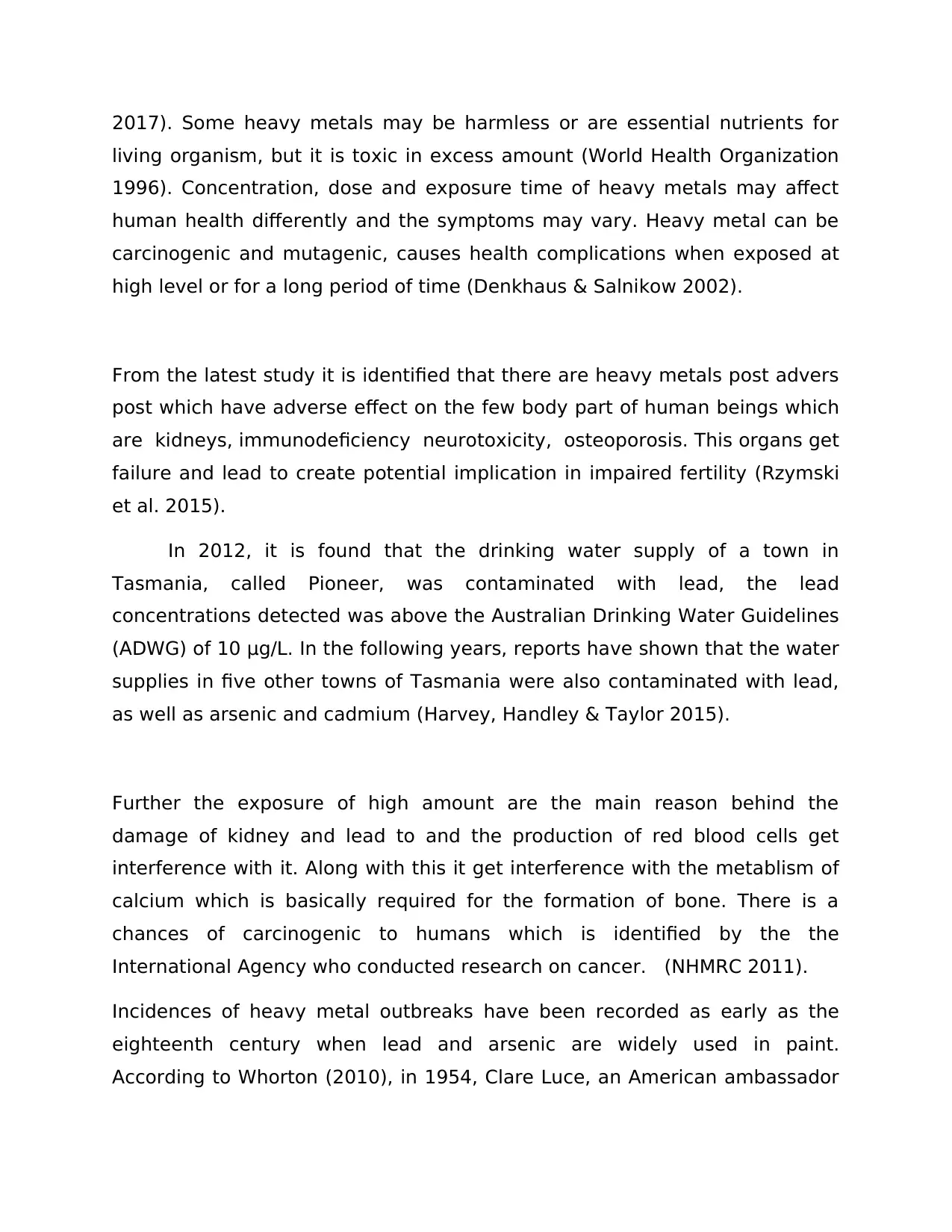
2017). Some heavy metals may be harmless or are essential nutrients for
living organism, but it is toxic in excess amount (World Health Organization
1996). Concentration, dose and exposure time of heavy metals may affect
human health differently and the symptoms may vary. Heavy metal can be
carcinogenic and mutagenic, causes health complications when exposed at
high level or for a long period of time (Denkhaus & Salnikow 2002).
From the latest study it is identified that there are heavy metals post advers
post which have adverse effect on the few body part of human beings which
are kidneys, immunodeficiency neurotoxicity, osteoporosis. This organs get
failure and lead to create potential implication in impaired fertility (Rzymski
et al. 2015).
In 2012, it is found that the drinking water supply of a town in
Tasmania, called Pioneer, was contaminated with lead, the lead
concentrations detected was above the Australian Drinking Water Guidelines
(ADWG) of 10 μg/L. In the following years, reports have shown that the water
supplies in five other towns of Tasmania were also contaminated with lead,
as well as arsenic and cadmium (Harvey, Handley & Taylor 2015).
Further the exposure of high amount are the main reason behind the
damage of kidney and lead to and the production of red blood cells get
interference with it. Along with this it get interference with the metablism of
calcium which is basically required for the formation of bone. There is a
chances of carcinogenic to humans which is identified by the the
International Agency who conducted research on cancer. (NHMRC 2011).
Incidences of heavy metal outbreaks have been recorded as early as the
eighteenth century when lead and arsenic are widely used in paint.
According to Whorton (2010), in 1954, Clare Luce, an American ambassador
living organism, but it is toxic in excess amount (World Health Organization
1996). Concentration, dose and exposure time of heavy metals may affect
human health differently and the symptoms may vary. Heavy metal can be
carcinogenic and mutagenic, causes health complications when exposed at
high level or for a long period of time (Denkhaus & Salnikow 2002).
From the latest study it is identified that there are heavy metals post advers
post which have adverse effect on the few body part of human beings which
are kidneys, immunodeficiency neurotoxicity, osteoporosis. This organs get
failure and lead to create potential implication in impaired fertility (Rzymski
et al. 2015).
In 2012, it is found that the drinking water supply of a town in
Tasmania, called Pioneer, was contaminated with lead, the lead
concentrations detected was above the Australian Drinking Water Guidelines
(ADWG) of 10 μg/L. In the following years, reports have shown that the water
supplies in five other towns of Tasmania were also contaminated with lead,
as well as arsenic and cadmium (Harvey, Handley & Taylor 2015).
Further the exposure of high amount are the main reason behind the
damage of kidney and lead to and the production of red blood cells get
interference with it. Along with this it get interference with the metablism of
calcium which is basically required for the formation of bone. There is a
chances of carcinogenic to humans which is identified by the the
International Agency who conducted research on cancer. (NHMRC 2011).
Incidences of heavy metal outbreaks have been recorded as early as the
eighteenth century when lead and arsenic are widely used in paint.
According to Whorton (2010), in 1954, Clare Luce, an American ambassador
Paraphrase This Document
Need a fresh take? Get an instant paraphrase of this document with our AI Paraphraser
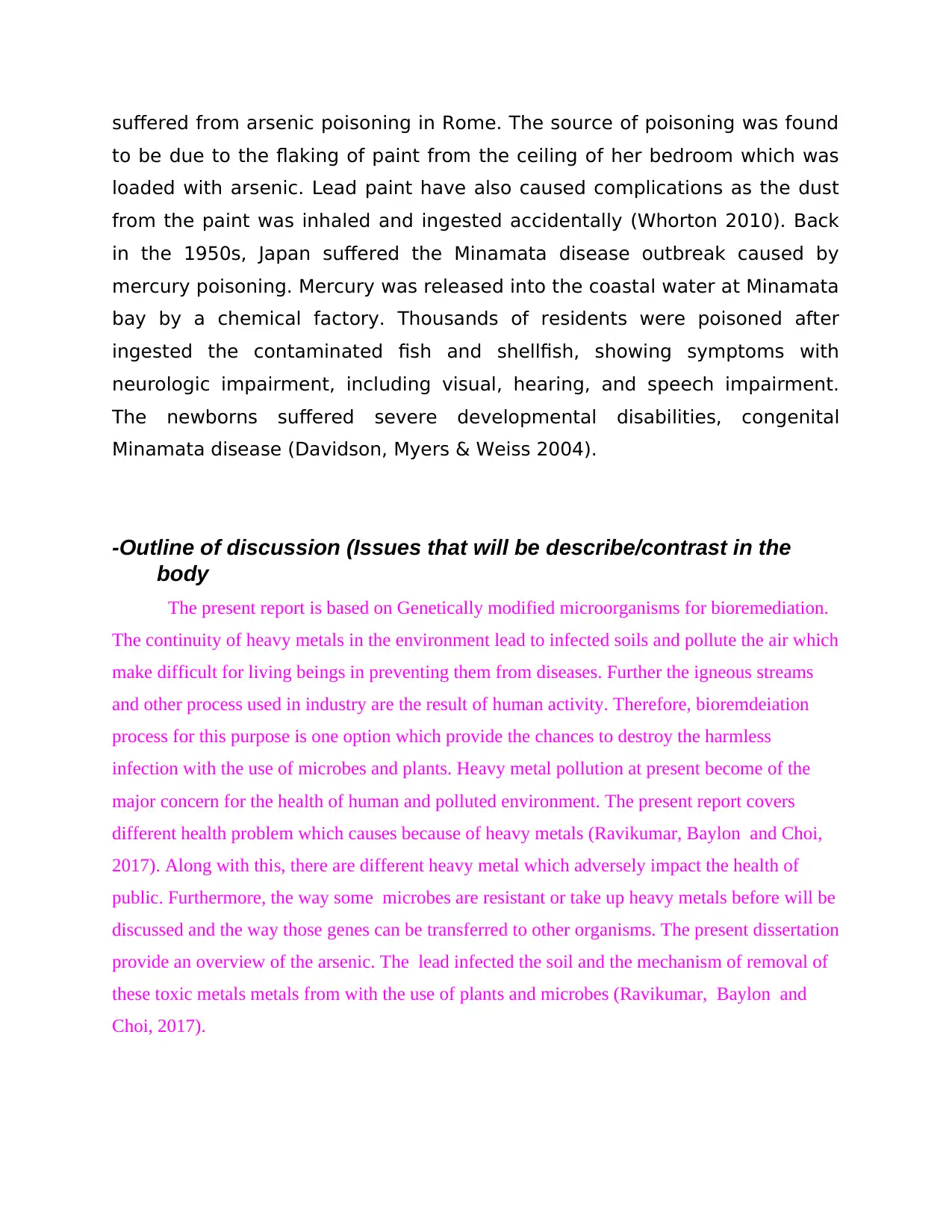
suffered from arsenic poisoning in Rome. The source of poisoning was found
to be due to the flaking of paint from the ceiling of her bedroom which was
loaded with arsenic. Lead paint have also caused complications as the dust
from the paint was inhaled and ingested accidentally (Whorton 2010). Back
in the 1950s, Japan suffered the Minamata disease outbreak caused by
mercury poisoning. Mercury was released into the coastal water at Minamata
bay by a chemical factory. Thousands of residents were poisoned after
ingested the contaminated fish and shellfish, showing symptoms with
neurologic impairment, including visual, hearing, and speech impairment.
The newborns suffered severe developmental disabilities, congenital
Minamata disease (Davidson, Myers & Weiss 2004).
-Outline of discussion (Issues that will be describe/contrast in the
body
The present report is based on Genetically modified microorganisms for bioremediation.
The continuity of heavy metals in the environment lead to infected soils and pollute the air which
make difficult for living beings in preventing them from diseases. Further the igneous streams
and other process used in industry are the result of human activity. Therefore, bioremdeiation
process for this purpose is one option which provide the chances to destroy the harmless
infection with the use of microbes and plants. Heavy metal pollution at present become of the
major concern for the health of human and polluted environment. The present report covers
different health problem which causes because of heavy metals (Ravikumar, Baylon and Choi,
2017). Along with this, there are different heavy metal which adversely impact the health of
public. Furthermore, the way some microbes are resistant or take up heavy metals before will be
discussed and the way those genes can be transferred to other organisms. The present dissertation
provide an overview of the arsenic. The lead infected the soil and the mechanism of removal of
these toxic metals metals from with the use of plants and microbes (Ravikumar, Baylon and
Choi, 2017).
to be due to the flaking of paint from the ceiling of her bedroom which was
loaded with arsenic. Lead paint have also caused complications as the dust
from the paint was inhaled and ingested accidentally (Whorton 2010). Back
in the 1950s, Japan suffered the Minamata disease outbreak caused by
mercury poisoning. Mercury was released into the coastal water at Minamata
bay by a chemical factory. Thousands of residents were poisoned after
ingested the contaminated fish and shellfish, showing symptoms with
neurologic impairment, including visual, hearing, and speech impairment.
The newborns suffered severe developmental disabilities, congenital
Minamata disease (Davidson, Myers & Weiss 2004).
-Outline of discussion (Issues that will be describe/contrast in the
body
The present report is based on Genetically modified microorganisms for bioremediation.
The continuity of heavy metals in the environment lead to infected soils and pollute the air which
make difficult for living beings in preventing them from diseases. Further the igneous streams
and other process used in industry are the result of human activity. Therefore, bioremdeiation
process for this purpose is one option which provide the chances to destroy the harmless
infection with the use of microbes and plants. Heavy metal pollution at present become of the
major concern for the health of human and polluted environment. The present report covers
different health problem which causes because of heavy metals (Ravikumar, Baylon and Choi,
2017). Along with this, there are different heavy metal which adversely impact the health of
public. Furthermore, the way some microbes are resistant or take up heavy metals before will be
discussed and the way those genes can be transferred to other organisms. The present dissertation
provide an overview of the arsenic. The lead infected the soil and the mechanism of removal of
these toxic metals metals from with the use of plants and microbes (Ravikumar, Baylon and
Choi, 2017).
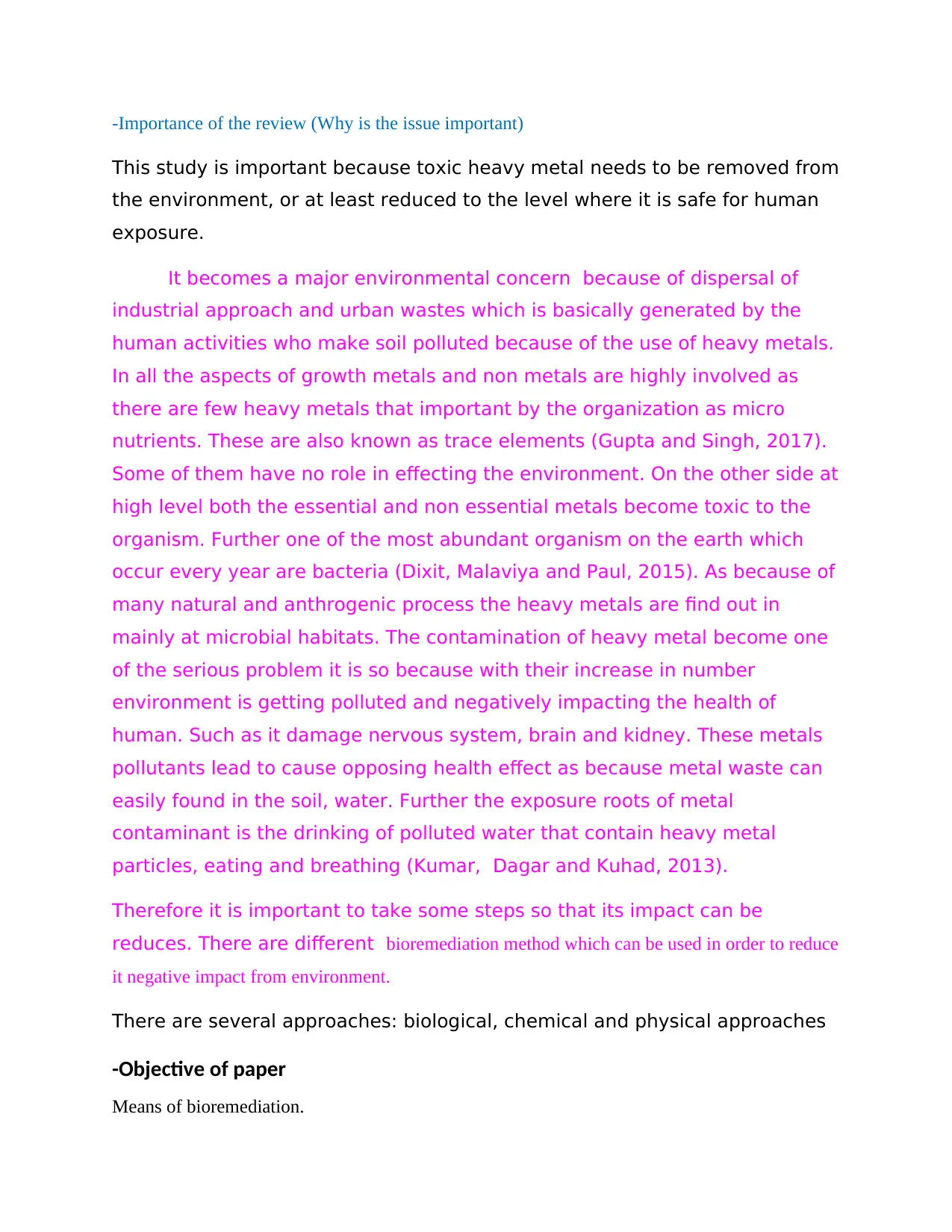
-Importance of the review (Why is the issue important)
This study is important because toxic heavy metal needs to be removed from
the environment, or at least reduced to the level where it is safe for human
exposure.
It becomes a major environmental concern because of dispersal of
industrial approach and urban wastes which is basically generated by the
human activities who make soil polluted because of the use of heavy metals.
In all the aspects of growth metals and non metals are highly involved as
there are few heavy metals that important by the organization as micro
nutrients. These are also known as trace elements (Gupta and Singh, 2017).
Some of them have no role in effecting the environment. On the other side at
high level both the essential and non essential metals become toxic to the
organism. Further one of the most abundant organism on the earth which
occur every year are bacteria (Dixit, Malaviya and Paul, 2015). As because of
many natural and anthrogenic process the heavy metals are find out in
mainly at microbial habitats. The contamination of heavy metal become one
of the serious problem it is so because with their increase in number
environment is getting polluted and negatively impacting the health of
human. Such as it damage nervous system, brain and kidney. These metals
pollutants lead to cause opposing health effect as because metal waste can
easily found in the soil, water. Further the exposure roots of metal
contaminant is the drinking of polluted water that contain heavy metal
particles, eating and breathing (Kumar, Dagar and Kuhad, 2013).
Therefore it is important to take some steps so that its impact can be
reduces. There are different bioremediation method which can be used in order to reduce
it negative impact from environment.
There are several approaches: biological, chemical and physical approaches
-Objective of paper
Means of bioremediation.
This study is important because toxic heavy metal needs to be removed from
the environment, or at least reduced to the level where it is safe for human
exposure.
It becomes a major environmental concern because of dispersal of
industrial approach and urban wastes which is basically generated by the
human activities who make soil polluted because of the use of heavy metals.
In all the aspects of growth metals and non metals are highly involved as
there are few heavy metals that important by the organization as micro
nutrients. These are also known as trace elements (Gupta and Singh, 2017).
Some of them have no role in effecting the environment. On the other side at
high level both the essential and non essential metals become toxic to the
organism. Further one of the most abundant organism on the earth which
occur every year are bacteria (Dixit, Malaviya and Paul, 2015). As because of
many natural and anthrogenic process the heavy metals are find out in
mainly at microbial habitats. The contamination of heavy metal become one
of the serious problem it is so because with their increase in number
environment is getting polluted and negatively impacting the health of
human. Such as it damage nervous system, brain and kidney. These metals
pollutants lead to cause opposing health effect as because metal waste can
easily found in the soil, water. Further the exposure roots of metal
contaminant is the drinking of polluted water that contain heavy metal
particles, eating and breathing (Kumar, Dagar and Kuhad, 2013).
Therefore it is important to take some steps so that its impact can be
reduces. There are different bioremediation method which can be used in order to reduce
it negative impact from environment.
There are several approaches: biological, chemical and physical approaches
-Objective of paper
Means of bioremediation.
⊘ This is a preview!⊘
Do you want full access?
Subscribe today to unlock all pages.

Trusted by 1+ million students worldwide
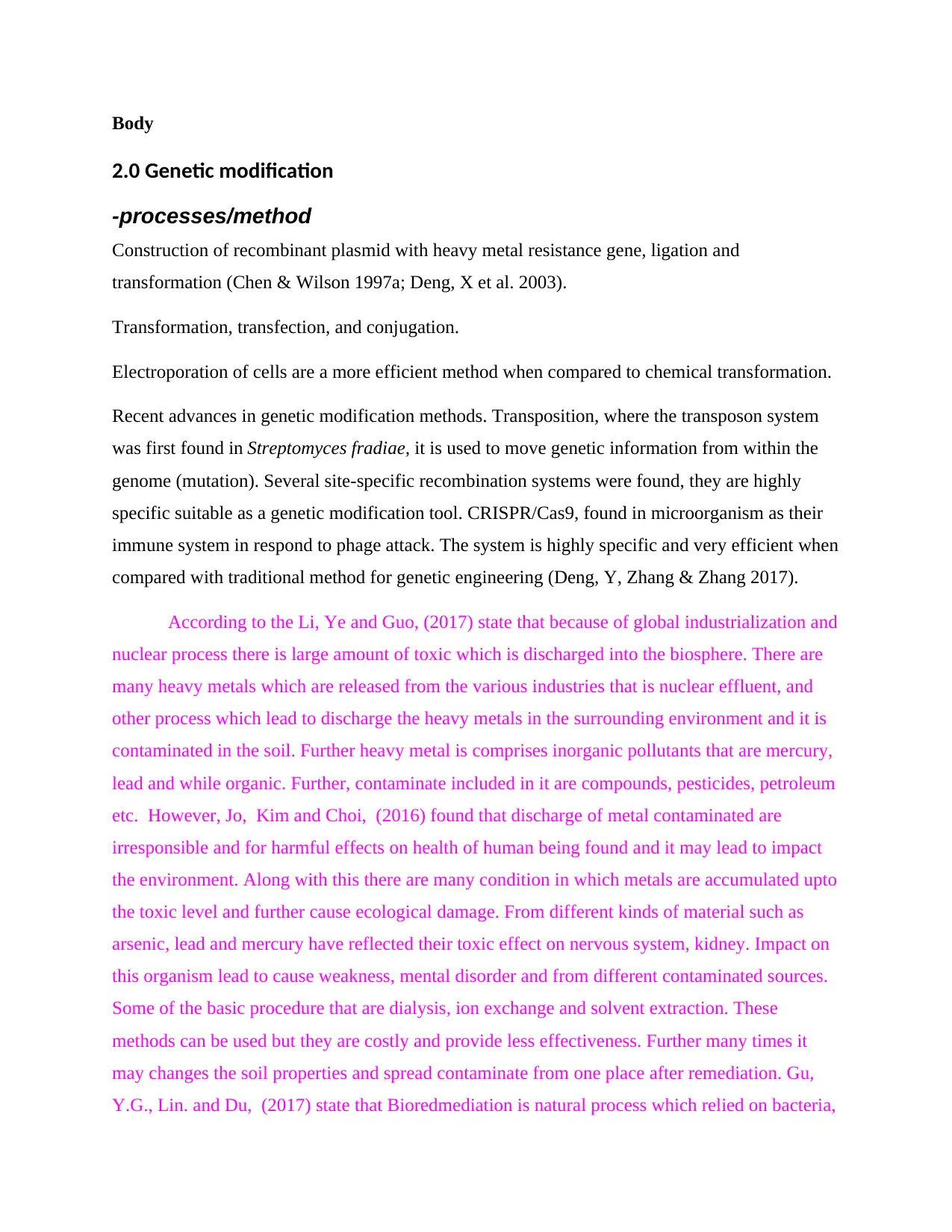
Body
2.0 Genetic modification
-processes/method
Construction of recombinant plasmid with heavy metal resistance gene, ligation and
transformation (Chen & Wilson 1997a; Deng, X et al. 2003).
Transformation, transfection, and conjugation.
Electroporation of cells are a more efficient method when compared to chemical transformation.
Recent advances in genetic modification methods. Transposition, where the transposon system
was first found in Streptomyces fradiae, it is used to move genetic information from within the
genome (mutation). Several site-specific recombination systems were found, they are highly
specific suitable as a genetic modification tool. CRISPR/Cas9, found in microorganism as their
immune system in respond to phage attack. The system is highly specific and very efficient when
compared with traditional method for genetic engineering (Deng, Y, Zhang & Zhang 2017).
According to the Li, Ye and Guo, (2017) state that because of global industrialization and
nuclear process there is large amount of toxic which is discharged into the biosphere. There are
many heavy metals which are released from the various industries that is nuclear effluent, and
other process which lead to discharge the heavy metals in the surrounding environment and it is
contaminated in the soil. Further heavy metal is comprises inorganic pollutants that are mercury,
lead and while organic. Further, contaminate included in it are compounds, pesticides, petroleum
etc. However, Jo, Kim and Choi, (2016) found that discharge of metal contaminated are
irresponsible and for harmful effects on health of human being found and it may lead to impact
the environment. Along with this there are many condition in which metals are accumulated upto
the toxic level and further cause ecological damage. From different kinds of material such as
arsenic, lead and mercury have reflected their toxic effect on nervous system, kidney. Impact on
this organism lead to cause weakness, mental disorder and from different contaminated sources.
Some of the basic procedure that are dialysis, ion exchange and solvent extraction. These
methods can be used but they are costly and provide less effectiveness. Further many times it
may changes the soil properties and spread contaminate from one place after remediation. Gu,
Y.G., Lin. and Du, (2017) state that Bioredmediation is natural process which relied on bacteria,
2.0 Genetic modification
-processes/method
Construction of recombinant plasmid with heavy metal resistance gene, ligation and
transformation (Chen & Wilson 1997a; Deng, X et al. 2003).
Transformation, transfection, and conjugation.
Electroporation of cells are a more efficient method when compared to chemical transformation.
Recent advances in genetic modification methods. Transposition, where the transposon system
was first found in Streptomyces fradiae, it is used to move genetic information from within the
genome (mutation). Several site-specific recombination systems were found, they are highly
specific suitable as a genetic modification tool. CRISPR/Cas9, found in microorganism as their
immune system in respond to phage attack. The system is highly specific and very efficient when
compared with traditional method for genetic engineering (Deng, Y, Zhang & Zhang 2017).
According to the Li, Ye and Guo, (2017) state that because of global industrialization and
nuclear process there is large amount of toxic which is discharged into the biosphere. There are
many heavy metals which are released from the various industries that is nuclear effluent, and
other process which lead to discharge the heavy metals in the surrounding environment and it is
contaminated in the soil. Further heavy metal is comprises inorganic pollutants that are mercury,
lead and while organic. Further, contaminate included in it are compounds, pesticides, petroleum
etc. However, Jo, Kim and Choi, (2016) found that discharge of metal contaminated are
irresponsible and for harmful effects on health of human being found and it may lead to impact
the environment. Along with this there are many condition in which metals are accumulated upto
the toxic level and further cause ecological damage. From different kinds of material such as
arsenic, lead and mercury have reflected their toxic effect on nervous system, kidney. Impact on
this organism lead to cause weakness, mental disorder and from different contaminated sources.
Some of the basic procedure that are dialysis, ion exchange and solvent extraction. These
methods can be used but they are costly and provide less effectiveness. Further many times it
may changes the soil properties and spread contaminate from one place after remediation. Gu,
Y.G., Lin. and Du, (2017) state that Bioredmediation is natural process which relied on bacteria,
Paraphrase This Document
Need a fresh take? Get an instant paraphrase of this document with our AI Paraphraser
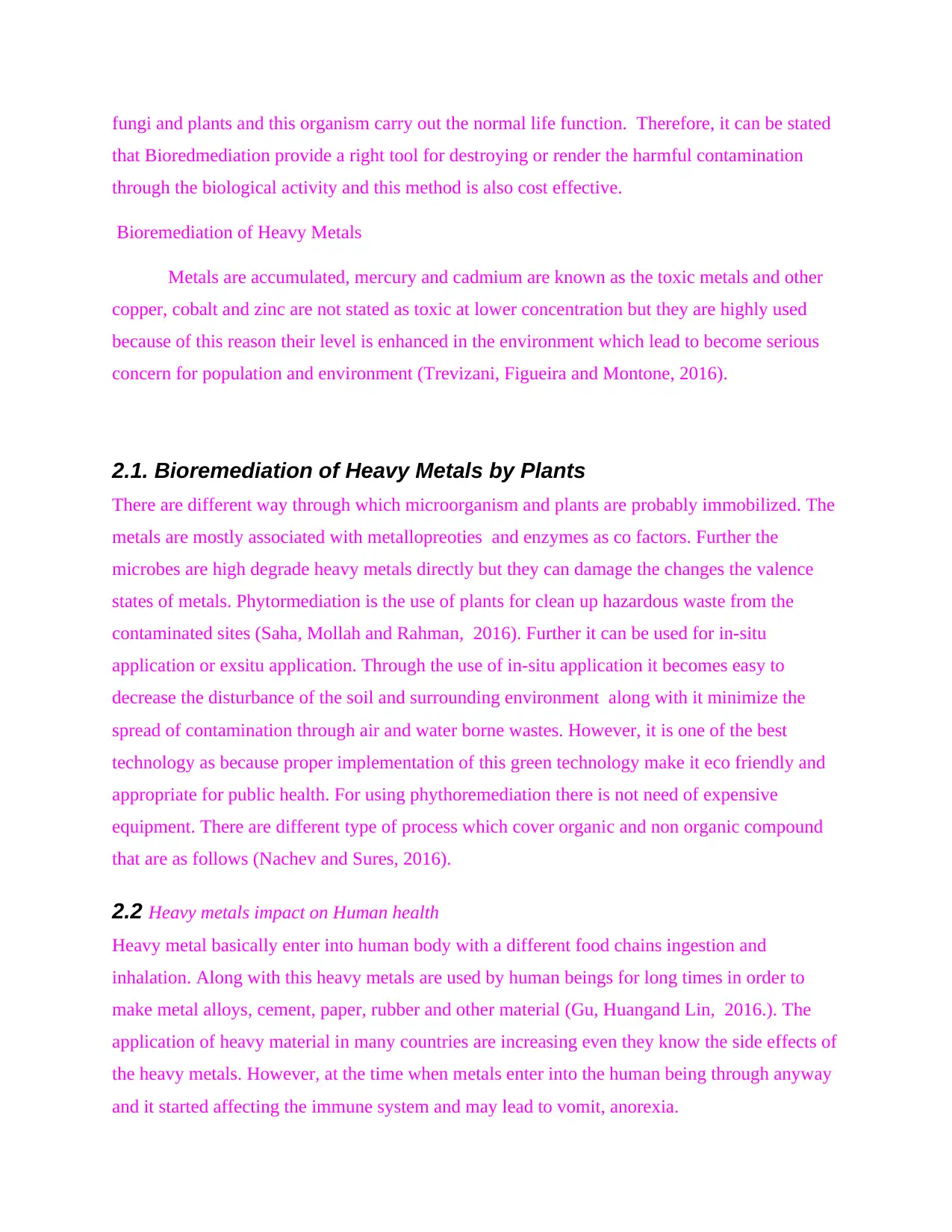
fungi and plants and this organism carry out the normal life function. Therefore, it can be stated
that Bioredmediation provide a right tool for destroying or render the harmful contamination
through the biological activity and this method is also cost effective.
Bioremediation of Heavy Metals
Metals are accumulated, mercury and cadmium are known as the toxic metals and other
copper, cobalt and zinc are not stated as toxic at lower concentration but they are highly used
because of this reason their level is enhanced in the environment which lead to become serious
concern for population and environment (Trevizani, Figueira and Montone, 2016).
2.1. Bioremediation of Heavy Metals by Plants
There are different way through which microorganism and plants are probably immobilized. The
metals are mostly associated with metallopreoties and enzymes as co factors. Further the
microbes are high degrade heavy metals directly but they can damage the changes the valence
states of metals. Phytormediation is the use of plants for clean up hazardous waste from the
contaminated sites (Saha, Mollah and Rahman, 2016). Further it can be used for in-situ
application or exsitu application. Through the use of in-situ application it becomes easy to
decrease the disturbance of the soil and surrounding environment along with it minimize the
spread of contamination through air and water borne wastes. However, it is one of the best
technology as because proper implementation of this green technology make it eco friendly and
appropriate for public health. For using phythoremediation there is not need of expensive
equipment. There are different type of process which cover organic and non organic compound
that are as follows (Nachev and Sures, 2016).
2.2 Heavy metals impact on Human health
Heavy metal basically enter into human body with a different food chains ingestion and
inhalation. Along with this heavy metals are used by human beings for long times in order to
make metal alloys, cement, paper, rubber and other material (Gu, Huangand Lin, 2016.). The
application of heavy material in many countries are increasing even they know the side effects of
the heavy metals. However, at the time when metals enter into the human being through anyway
and it started affecting the immune system and may lead to vomit, anorexia.
that Bioredmediation provide a right tool for destroying or render the harmful contamination
through the biological activity and this method is also cost effective.
Bioremediation of Heavy Metals
Metals are accumulated, mercury and cadmium are known as the toxic metals and other
copper, cobalt and zinc are not stated as toxic at lower concentration but they are highly used
because of this reason their level is enhanced in the environment which lead to become serious
concern for population and environment (Trevizani, Figueira and Montone, 2016).
2.1. Bioremediation of Heavy Metals by Plants
There are different way through which microorganism and plants are probably immobilized. The
metals are mostly associated with metallopreoties and enzymes as co factors. Further the
microbes are high degrade heavy metals directly but they can damage the changes the valence
states of metals. Phytormediation is the use of plants for clean up hazardous waste from the
contaminated sites (Saha, Mollah and Rahman, 2016). Further it can be used for in-situ
application or exsitu application. Through the use of in-situ application it becomes easy to
decrease the disturbance of the soil and surrounding environment along with it minimize the
spread of contamination through air and water borne wastes. However, it is one of the best
technology as because proper implementation of this green technology make it eco friendly and
appropriate for public health. For using phythoremediation there is not need of expensive
equipment. There are different type of process which cover organic and non organic compound
that are as follows (Nachev and Sures, 2016).
2.2 Heavy metals impact on Human health
Heavy metal basically enter into human body with a different food chains ingestion and
inhalation. Along with this heavy metals are used by human beings for long times in order to
make metal alloys, cement, paper, rubber and other material (Gu, Huangand Lin, 2016.). The
application of heavy material in many countries are increasing even they know the side effects of
the heavy metals. However, at the time when metals enter into the human being through anyway
and it started affecting the immune system and may lead to vomit, anorexia.
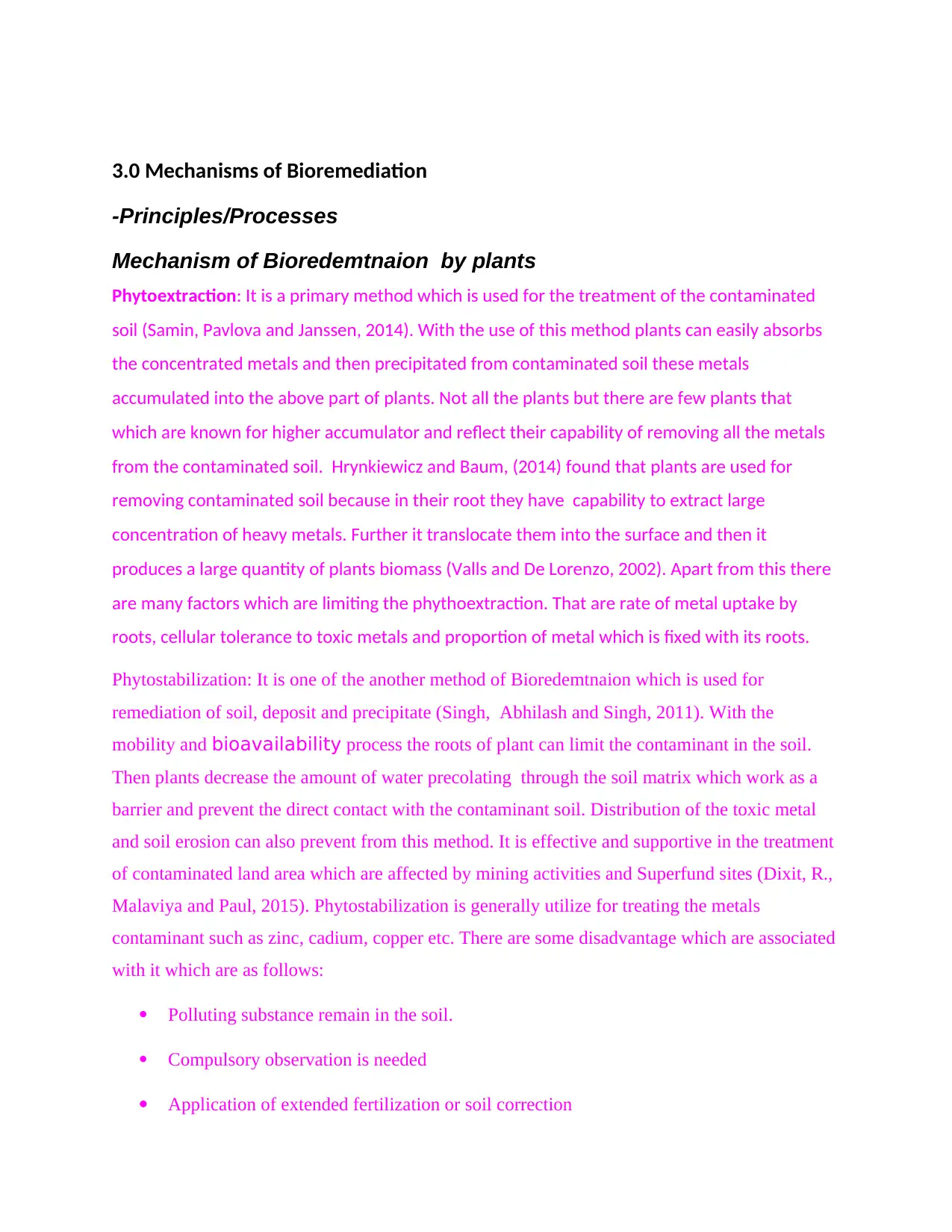
3.0 Mechanisms of Bioremediation
-Principles/Processes
Mechanism of Bioredemtnaion by plants
Phytoextraction: It is a primary method which is used for the treatment of the contaminated
soil (Samin, Pavlova and Janssen, 2014). With the use of this method plants can easily absorbs
the concentrated metals and then precipitated from contaminated soil these metals
accumulated into the above part of plants. Not all the plants but there are few plants that
which are known for higher accumulator and reflect their capability of removing all the metals
from the contaminated soil. Hrynkiewicz and Baum, (2014) found that plants are used for
removing contaminated soil because in their root they have capability to extract large
concentration of heavy metals. Further it translocate them into the surface and then it
produces a large quantity of plants biomass (Valls and De Lorenzo, 2002). Apart from this there
are many factors which are limiting the phythoextraction. That are rate of metal uptake by
roots, cellular tolerance to toxic metals and proportion of metal which is fixed with its roots.
Phytostabilization: It is one of the another method of Bioredemtnaion which is used for
remediation of soil, deposit and precipitate (Singh, Abhilash and Singh, 2011). With the
mobility and bioavailability process the roots of plant can limit the contaminant in the soil.
Then plants decrease the amount of water precolating through the soil matrix which work as a
barrier and prevent the direct contact with the contaminant soil. Distribution of the toxic metal
and soil erosion can also prevent from this method. It is effective and supportive in the treatment
of contaminated land area which are affected by mining activities and Superfund sites (Dixit, R.,
Malaviya and Paul, 2015). Phytostabilization is generally utilize for treating the metals
contaminant such as zinc, cadium, copper etc. There are some disadvantage which are associated
with it which are as follows:
Polluting substance remain in the soil.
Compulsory observation is needed
Application of extended fertilization or soil correction
-Principles/Processes
Mechanism of Bioredemtnaion by plants
Phytoextraction: It is a primary method which is used for the treatment of the contaminated
soil (Samin, Pavlova and Janssen, 2014). With the use of this method plants can easily absorbs
the concentrated metals and then precipitated from contaminated soil these metals
accumulated into the above part of plants. Not all the plants but there are few plants that
which are known for higher accumulator and reflect their capability of removing all the metals
from the contaminated soil. Hrynkiewicz and Baum, (2014) found that plants are used for
removing contaminated soil because in their root they have capability to extract large
concentration of heavy metals. Further it translocate them into the surface and then it
produces a large quantity of plants biomass (Valls and De Lorenzo, 2002). Apart from this there
are many factors which are limiting the phythoextraction. That are rate of metal uptake by
roots, cellular tolerance to toxic metals and proportion of metal which is fixed with its roots.
Phytostabilization: It is one of the another method of Bioredemtnaion which is used for
remediation of soil, deposit and precipitate (Singh, Abhilash and Singh, 2011). With the
mobility and bioavailability process the roots of plant can limit the contaminant in the soil.
Then plants decrease the amount of water precolating through the soil matrix which work as a
barrier and prevent the direct contact with the contaminant soil. Distribution of the toxic metal
and soil erosion can also prevent from this method. It is effective and supportive in the treatment
of contaminated land area which are affected by mining activities and Superfund sites (Dixit, R.,
Malaviya and Paul, 2015). Phytostabilization is generally utilize for treating the metals
contaminant such as zinc, cadium, copper etc. There are some disadvantage which are associated
with it which are as follows:
Polluting substance remain in the soil.
Compulsory observation is needed
Application of extended fertilization or soil correction
⊘ This is a preview!⊘
Do you want full access?
Subscribe today to unlock all pages.

Trusted by 1+ million students worldwide
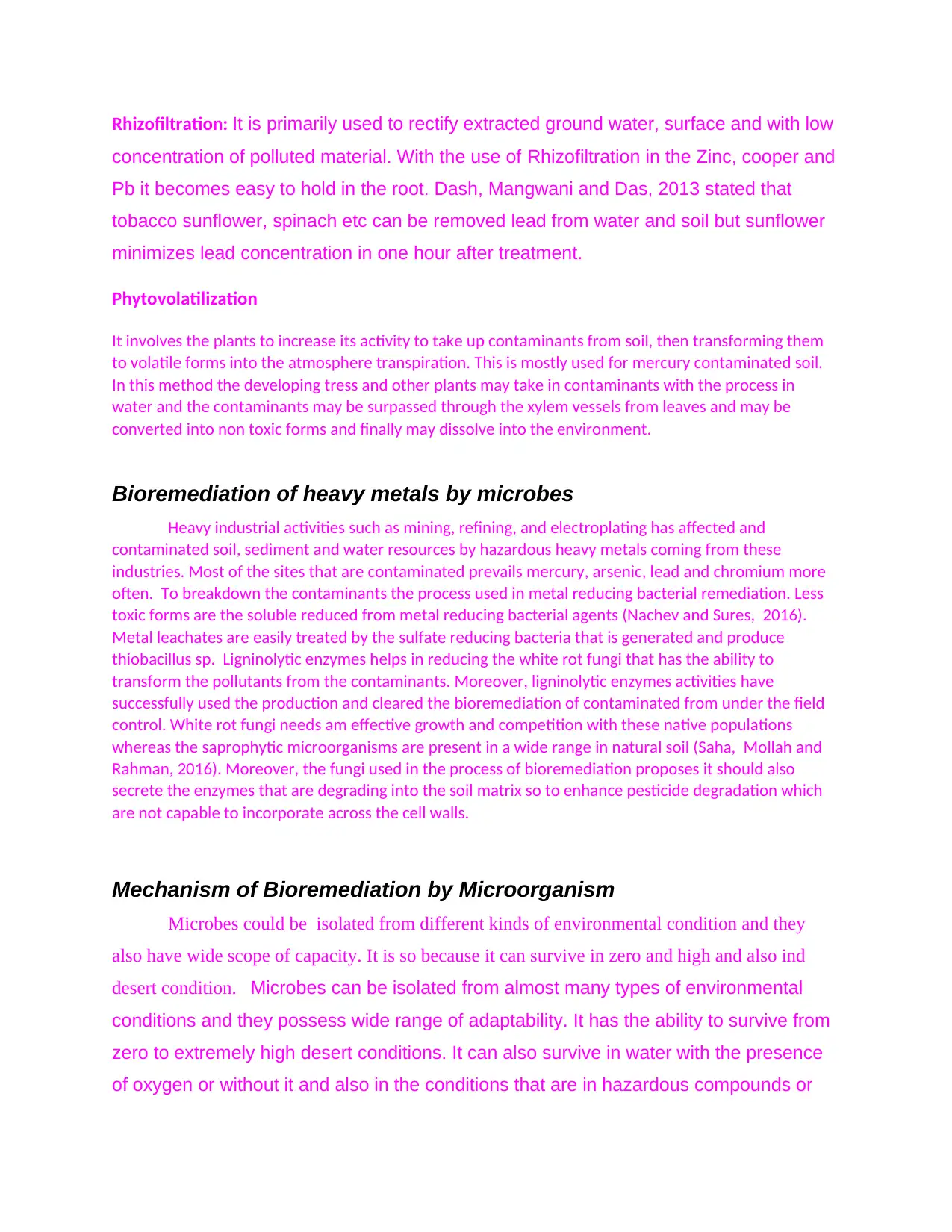
Rhizofiltration: It is primarily used to rectify extracted ground water, surface and with low
concentration of polluted material. With the use of Rhizofiltration in the Zinc, cooper and
Pb it becomes easy to hold in the root. Dash, Mangwani and Das, 2013 stated that
tobacco sunflower, spinach etc can be removed lead from water and soil but sunflower
minimizes lead concentration in one hour after treatment.
Phytovolatilization
It involves the plants to increase its activity to take up contaminants from soil, then transforming them
to volatile forms into the atmosphere transpiration. This is mostly used for mercury contaminated soil.
In this method the developing tress and other plants may take in contaminants with the process in
water and the contaminants may be surpassed through the xylem vessels from leaves and may be
converted into non toxic forms and finally may dissolve into the environment.
Bioremediation of heavy metals by microbes
Heavy industrial activities such as mining, refining, and electroplating has affected and
contaminated soil, sediment and water resources by hazardous heavy metals coming from these
industries. Most of the sites that are contaminated prevails mercury, arsenic, lead and chromium more
often. To breakdown the contaminants the process used in metal reducing bacterial remediation. Less
toxic forms are the soluble reduced from metal reducing bacterial agents (Nachev and Sures, 2016).
Metal leachates are easily treated by the sulfate reducing bacteria that is generated and produce
thiobacillus sp. Ligninolytic enzymes helps in reducing the white rot fungi that has the ability to
transform the pollutants from the contaminants. Moreover, ligninolytic enzymes activities have
successfully used the production and cleared the bioremediation of contaminated from under the field
control. White rot fungi needs am effective growth and competition with these native populations
whereas the saprophytic microorganisms are present in a wide range in natural soil (Saha, Mollah and
Rahman, 2016). Moreover, the fungi used in the process of bioremediation proposes it should also
secrete the enzymes that are degrading into the soil matrix so to enhance pesticide degradation which
are not capable to incorporate across the cell walls.
Mechanism of Bioremediation by Microorganism
Microbes could be isolated from different kinds of environmental condition and they
also have wide scope of capacity. It is so because it can survive in zero and high and also ind
desert condition. Microbes can be isolated from almost many types of environmental
conditions and they possess wide range of adaptability. It has the ability to survive from
zero to extremely high desert conditions. It can also survive in water with the presence
of oxygen or without it and also in the conditions that are in hazardous compounds or
concentration of polluted material. With the use of Rhizofiltration in the Zinc, cooper and
Pb it becomes easy to hold in the root. Dash, Mangwani and Das, 2013 stated that
tobacco sunflower, spinach etc can be removed lead from water and soil but sunflower
minimizes lead concentration in one hour after treatment.
Phytovolatilization
It involves the plants to increase its activity to take up contaminants from soil, then transforming them
to volatile forms into the atmosphere transpiration. This is mostly used for mercury contaminated soil.
In this method the developing tress and other plants may take in contaminants with the process in
water and the contaminants may be surpassed through the xylem vessels from leaves and may be
converted into non toxic forms and finally may dissolve into the environment.
Bioremediation of heavy metals by microbes
Heavy industrial activities such as mining, refining, and electroplating has affected and
contaminated soil, sediment and water resources by hazardous heavy metals coming from these
industries. Most of the sites that are contaminated prevails mercury, arsenic, lead and chromium more
often. To breakdown the contaminants the process used in metal reducing bacterial remediation. Less
toxic forms are the soluble reduced from metal reducing bacterial agents (Nachev and Sures, 2016).
Metal leachates are easily treated by the sulfate reducing bacteria that is generated and produce
thiobacillus sp. Ligninolytic enzymes helps in reducing the white rot fungi that has the ability to
transform the pollutants from the contaminants. Moreover, ligninolytic enzymes activities have
successfully used the production and cleared the bioremediation of contaminated from under the field
control. White rot fungi needs am effective growth and competition with these native populations
whereas the saprophytic microorganisms are present in a wide range in natural soil (Saha, Mollah and
Rahman, 2016). Moreover, the fungi used in the process of bioremediation proposes it should also
secrete the enzymes that are degrading into the soil matrix so to enhance pesticide degradation which
are not capable to incorporate across the cell walls.
Mechanism of Bioremediation by Microorganism
Microbes could be isolated from different kinds of environmental condition and they
also have wide scope of capacity. It is so because it can survive in zero and high and also ind
desert condition. Microbes can be isolated from almost many types of environmental
conditions and they possess wide range of adaptability. It has the ability to survive from
zero to extremely high desert conditions. It can also survive in water with the presence
of oxygen or without it and also in the conditions that are in hazardous compounds or
Paraphrase This Document
Need a fresh take? Get an instant paraphrase of this document with our AI Paraphraser
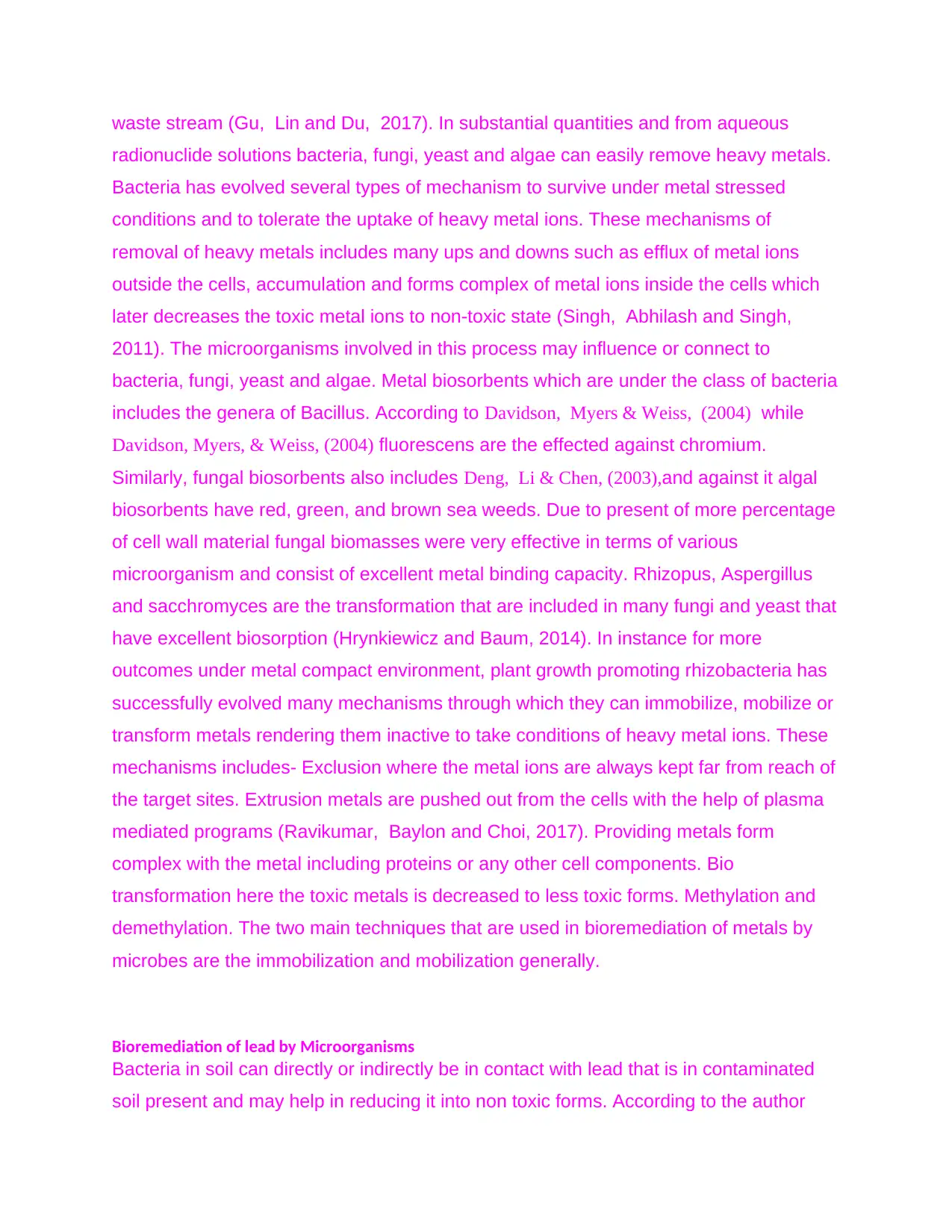
waste stream (Gu, Lin and Du, 2017). In substantial quantities and from aqueous
radionuclide solutions bacteria, fungi, yeast and algae can easily remove heavy metals.
Bacteria has evolved several types of mechanism to survive under metal stressed
conditions and to tolerate the uptake of heavy metal ions. These mechanisms of
removal of heavy metals includes many ups and downs such as efflux of metal ions
outside the cells, accumulation and forms complex of metal ions inside the cells which
later decreases the toxic metal ions to non-toxic state (Singh, Abhilash and Singh,
2011). The microorganisms involved in this process may influence or connect to
bacteria, fungi, yeast and algae. Metal biosorbents which are under the class of bacteria
includes the genera of Bacillus. According to Davidson, Myers & Weiss, (2004) while
Davidson, Myers, & Weiss, (2004) fluorescens are the effected against chromium.
Similarly, fungal biosorbents also includes Deng, Li & Chen, (2003),and against it algal
biosorbents have red, green, and brown sea weeds. Due to present of more percentage
of cell wall material fungal biomasses were very effective in terms of various
microorganism and consist of excellent metal binding capacity. Rhizopus, Aspergillus
and sacchromyces are the transformation that are included in many fungi and yeast that
have excellent biosorption (Hrynkiewicz and Baum, 2014). In instance for more
outcomes under metal compact environment, plant growth promoting rhizobacteria has
successfully evolved many mechanisms through which they can immobilize, mobilize or
transform metals rendering them inactive to take conditions of heavy metal ions. These
mechanisms includes- Exclusion where the metal ions are always kept far from reach of
the target sites. Extrusion metals are pushed out from the cells with the help of plasma
mediated programs (Ravikumar, Baylon and Choi, 2017). Providing metals form
complex with the metal including proteins or any other cell components. Bio
transformation here the toxic metals is decreased to less toxic forms. Methylation and
demethylation. The two main techniques that are used in bioremediation of metals by
microbes are the immobilization and mobilization generally.
Bioremediation of lead by Microorganisms
Bacteria in soil can directly or indirectly be in contact with lead that is in contaminated
soil present and may help in reducing it into non toxic forms. According to the author
radionuclide solutions bacteria, fungi, yeast and algae can easily remove heavy metals.
Bacteria has evolved several types of mechanism to survive under metal stressed
conditions and to tolerate the uptake of heavy metal ions. These mechanisms of
removal of heavy metals includes many ups and downs such as efflux of metal ions
outside the cells, accumulation and forms complex of metal ions inside the cells which
later decreases the toxic metal ions to non-toxic state (Singh, Abhilash and Singh,
2011). The microorganisms involved in this process may influence or connect to
bacteria, fungi, yeast and algae. Metal biosorbents which are under the class of bacteria
includes the genera of Bacillus. According to Davidson, Myers & Weiss, (2004) while
Davidson, Myers, & Weiss, (2004) fluorescens are the effected against chromium.
Similarly, fungal biosorbents also includes Deng, Li & Chen, (2003),and against it algal
biosorbents have red, green, and brown sea weeds. Due to present of more percentage
of cell wall material fungal biomasses were very effective in terms of various
microorganism and consist of excellent metal binding capacity. Rhizopus, Aspergillus
and sacchromyces are the transformation that are included in many fungi and yeast that
have excellent biosorption (Hrynkiewicz and Baum, 2014). In instance for more
outcomes under metal compact environment, plant growth promoting rhizobacteria has
successfully evolved many mechanisms through which they can immobilize, mobilize or
transform metals rendering them inactive to take conditions of heavy metal ions. These
mechanisms includes- Exclusion where the metal ions are always kept far from reach of
the target sites. Extrusion metals are pushed out from the cells with the help of plasma
mediated programs (Ravikumar, Baylon and Choi, 2017). Providing metals form
complex with the metal including proteins or any other cell components. Bio
transformation here the toxic metals is decreased to less toxic forms. Methylation and
demethylation. The two main techniques that are used in bioremediation of metals by
microbes are the immobilization and mobilization generally.
Bioremediation of lead by Microorganisms
Bacteria in soil can directly or indirectly be in contact with lead that is in contaminated
soil present and may help in reducing it into non toxic forms. According to the author
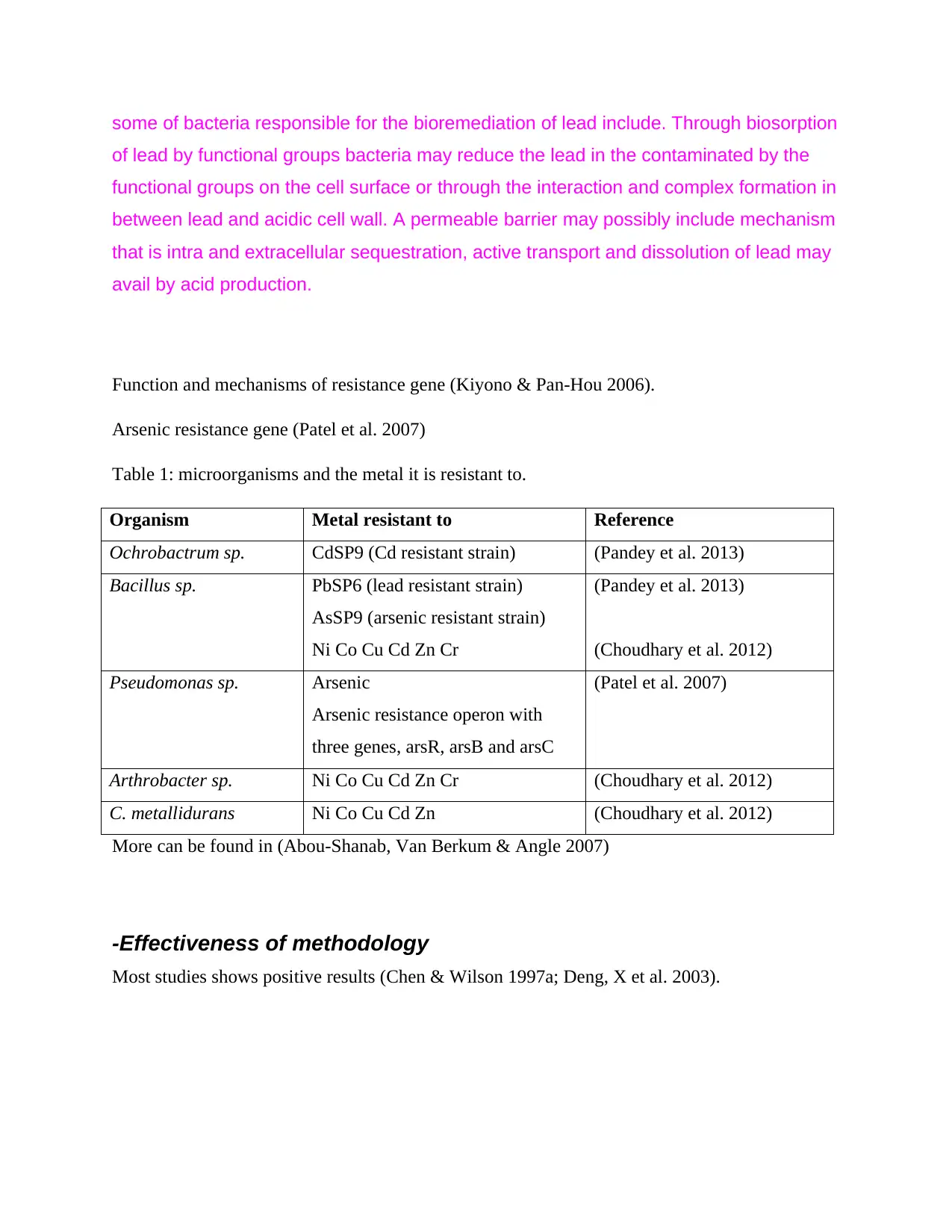
some of bacteria responsible for the bioremediation of lead include. Through biosorption
of lead by functional groups bacteria may reduce the lead in the contaminated by the
functional groups on the cell surface or through the interaction and complex formation in
between lead and acidic cell wall. A permeable barrier may possibly include mechanism
that is intra and extracellular sequestration, active transport and dissolution of lead may
avail by acid production.
Function and mechanisms of resistance gene (Kiyono & Pan-Hou 2006).
Arsenic resistance gene (Patel et al. 2007)
Table 1: microorganisms and the metal it is resistant to.
Organism Metal resistant to Reference
Ochrobactrum sp. CdSP9 (Cd resistant strain) (Pandey et al. 2013)
Bacillus sp. PbSP6 (lead resistant strain)
AsSP9 (arsenic resistant strain)
Ni Co Cu Cd Zn Cr
(Pandey et al. 2013)
(Choudhary et al. 2012)
Pseudomonas sp. Arsenic
Arsenic resistance operon with
three genes, arsR, arsB and arsC
(Patel et al. 2007)
Arthrobacter sp. Ni Co Cu Cd Zn Cr (Choudhary et al. 2012)
C. metallidurans Ni Co Cu Cd Zn (Choudhary et al. 2012)
More can be found in (Abou-Shanab, Van Berkum & Angle 2007)
-Effectiveness of methodology
Most studies shows positive results (Chen & Wilson 1997a; Deng, X et al. 2003).
of lead by functional groups bacteria may reduce the lead in the contaminated by the
functional groups on the cell surface or through the interaction and complex formation in
between lead and acidic cell wall. A permeable barrier may possibly include mechanism
that is intra and extracellular sequestration, active transport and dissolution of lead may
avail by acid production.
Function and mechanisms of resistance gene (Kiyono & Pan-Hou 2006).
Arsenic resistance gene (Patel et al. 2007)
Table 1: microorganisms and the metal it is resistant to.
Organism Metal resistant to Reference
Ochrobactrum sp. CdSP9 (Cd resistant strain) (Pandey et al. 2013)
Bacillus sp. PbSP6 (lead resistant strain)
AsSP9 (arsenic resistant strain)
Ni Co Cu Cd Zn Cr
(Pandey et al. 2013)
(Choudhary et al. 2012)
Pseudomonas sp. Arsenic
Arsenic resistance operon with
three genes, arsR, arsB and arsC
(Patel et al. 2007)
Arthrobacter sp. Ni Co Cu Cd Zn Cr (Choudhary et al. 2012)
C. metallidurans Ni Co Cu Cd Zn (Choudhary et al. 2012)
More can be found in (Abou-Shanab, Van Berkum & Angle 2007)
-Effectiveness of methodology
Most studies shows positive results (Chen & Wilson 1997a; Deng, X et al. 2003).
⊘ This is a preview!⊘
Do you want full access?
Subscribe today to unlock all pages.

Trusted by 1+ million students worldwide
1 out of 19
Related Documents
Your All-in-One AI-Powered Toolkit for Academic Success.
+13062052269
info@desklib.com
Available 24*7 on WhatsApp / Email
![[object Object]](/_next/static/media/star-bottom.7253800d.svg)
Unlock your academic potential
Copyright © 2020–2025 A2Z Services. All Rights Reserved. Developed and managed by ZUCOL.





